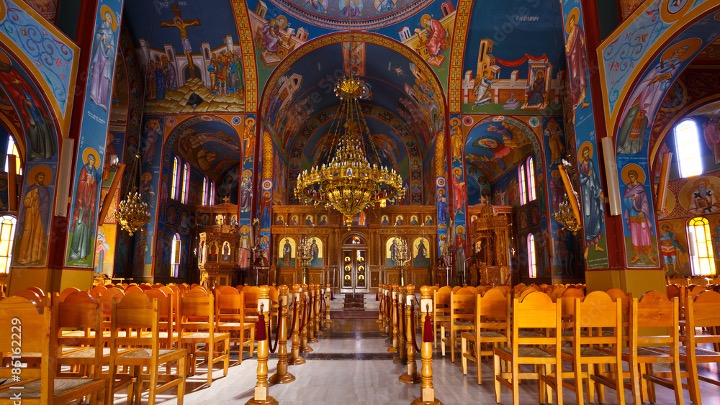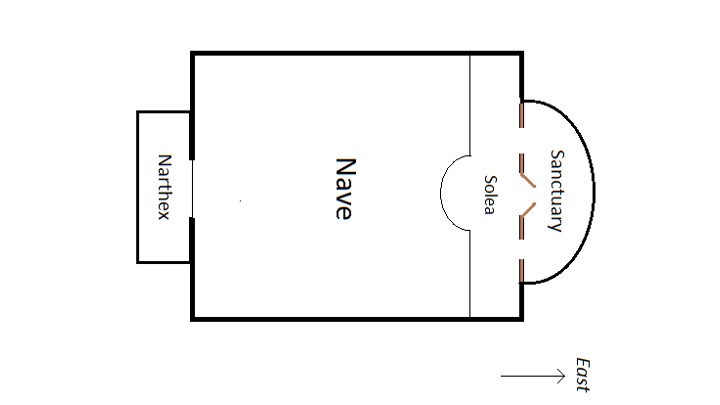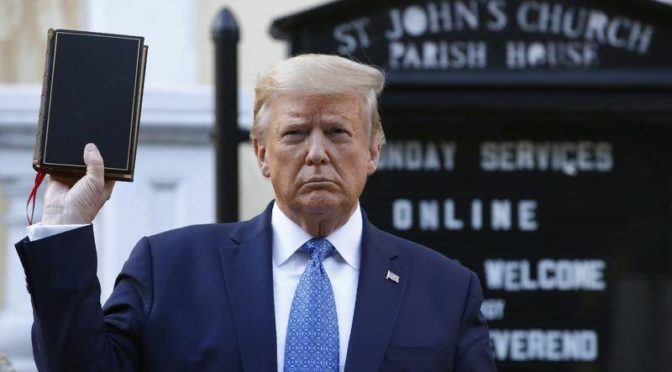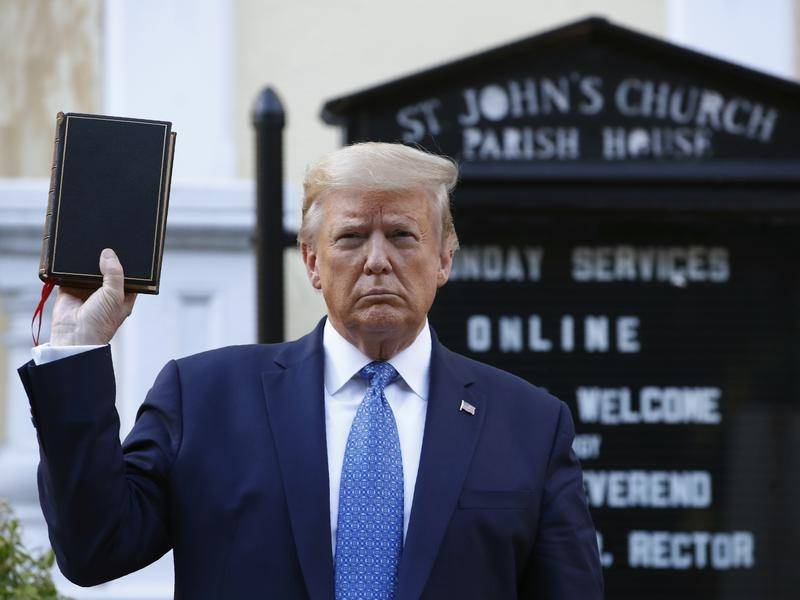This was part four of a sermon series preached at City South Presbyterian Church in 2024. You can listen to this on our podcast, or watch the video.

What should God’s house look like?
If you were building a physical thing on earth to teach yourself, and others, what heaven looks like — or what heaven on earth looks like — dwelling with God — somewhere you could go to visualise this reality — what would you build?
This is the dilemma that has faced church architects for centuries — right — from the time Christians met in houses, to when we could meet publicly in halls, to when we could build structures.
And part of that dilemma is: are our churches temples? How should they relate to the temple in the Bible? The temple is often called God’s dwelling place in the Bible — but what is a temple? What does it mean for the God of heaven to dwell on earth anyway — especially as we are looking at how followers of Jesus are raised and seated in the throne room of heaven, so our lives on earth reflect this reality (Ephesians 2:6).
Back in week one we touched on this idea that we — God’s “heaven on earth” people — are his temple (Ephesians 2:21–22).
So how do we be a temple?
What pictures should shape our imaginations? What vision of heaven should shape us as we live in space and time? How do the passages in the Bible about temples shape what we become?
This is not easy. What we are going to do today is a little ambitious, and this theme is so broad and rich that really it is just an example of the sort of meditation on some imagery in Scripture that we are trying to practice together this series.
There are lots of other rich threads you might pick up over a lifetime. I reckon you could pick any aspect of the design of the tabernacle or temple in the Old Testament — or its furnishings — to contemplate, and see how they are fulfilled in Jesus and point to the ultimate heaven on earth reality he brings us into. Not just our current location in the heavens with him, but the future reality of heaven and earth being brought together as one as we live in God’s presence — his house — forever.
We have also got some limitations in our tradition when it comes to thinking this way. If you were answering this question — about what God’s house might look like — both anticipating heaven, and looking back to the story of the Bible as someone in the Orthodox tradition, sitting — or standing — in church — you would just have to look around.

In the Orthodox tradition churches are built to tell this story — right from the ground — the floor plan, which maps out who lives where on earth — to the ceiling, where you might find a dome as a picture of the heavens above.

In a traditional Orthodox church, those not part of the church yet — those not baptised or received into the life of the house — remain in the narthex, while the members of the church gather in the nave, and the priests and bishops “mediate” heaven to earth from the sanctuary, which is where the Eucharist is served from as Jesus’ body and blood are given to the congregation. It is separated from the nave by a wall with doors that is covered with icons — imagery of saints — those in heaven.
You go to church in this sort of space and it teaches something about their view of heaven and earth. It functions a bit like the temple.
We do not tend to think about imagery or architecture like this — and we are often worried about idolatry — but there is a danger this stunts our imagination, leaving us just with the words in the Bible, without aids to picture what those words describe. This is tricky territory to navigate, especially if part of our task as image-bearing people is to live in ways that picture heaven-on-earth life now. And maybe it leaves us with fewer tools than God’s people in Israel, who had a whole architecture and set of rhythms to teach them life as God’s people; architecture fulfilled in Jesus, pointing to him.
The writer of Hebrews draws heavily on imagery from the temple and the life of Israel — and connects this to the story of Jesus and our place now in a heavenly temple. They say Jesus is a high priest — the king seated at the right hand of the throne of the majesty in heaven also serves in a sanctuary — the “true tabernacle” — that is a dwelling place — built by God, not by humans (Hebrews 8:1–2). This is the temple we now have access to through Jesus as those raised and seated with him. They also say some things about the reality of the previous dwelling places of God… and the earthly temple in Jerusalem before it was destroyed by the Romans…
The writer of Hebrews tells us that these Old Testament designs — built by humans — were, right from Moses with the tabernacle, attempts to build things on earth that reflected this heavenly dwelling of God that Moses sees on the mountain. They are tools designed to reflect what heaven is like, what God is like, and how to live as people who dwell with God. They are “a copy and a shadow of what is in heaven” (Hebrews 8:5).
The tabernacle that belonged to what the writer of Hebrews calls “the old covenant” — an old way of doing business with God, in relationship with him — is contrasted with the new covenant described in a bit we skipped, which quotes Jeremiah talking about God writing his law on hearts, rather than on stone tablets they keep in a box, where people will not need a temple to teach us how God works because they will know him (Hebrews 8:10–11), where sins and wickedness will be forgiven and made no more (Hebrews 8:12).
For the writer of Hebrews this happens as the perpetual sacrifices in the temple are replaced with the once-for-all sacrifice of Jesus. The old covenant had patterns of worship — rhythms of coming before God — and architecture — a sanctuary with a floor plan, and furnishings that lined up with this way of doing things, helping people picture and live out this arrangement between heaven and earth. It had a holy place and a most holy place, and furniture that helped people move from one place to the other — or a priest to do this — through sacrifices and being made symbolically clean — in order to enter heaven-on-earth space. There was a golden altar and a golden ark of the covenant, and above the ark there were these cherubim — pictures of heavenly creatures from the throne room of God — which the writer of Hebrews does not dig into — and maybe preachers like me could learn from them (Hebrews 9:1–5)… because we are going to dig into the details a bit… but let’s finish the Hebrews thread first, which stresses how old covenant priests did a bunch of business in the outer room, but could only go into the most holy place once a year, with blood offered as an atoning sacrifice on behalf of the people. That word atonement — it is a word about restoration of relationship, not just forgiveness — a sacrifice so people could keep living with God at the heart of their community.
The Holy Spirit was using this imagery — this architecture, and these rhythms — to show that the way into life with God, the most holy place, heaven on earth, was not open, and could not be while this first dwelling place — the tabernacle, and then the more permanent temple — were functioning (Hebrews 9:7). Which I guess means whatever architecture and rhythms we take up would have to help us see how the way is open. This was an illustration — a picture — an image — of the first covenant being inadequate for actually transforming a worshipper into a heaven-on-earth person. Not just the people, even the priest. A picture fulfilled (Hebrews 9:9).
But now, Jesus the true high priest has made a way into the true temple — the heavenly dwelling place — the place we are trying to imagine ourselves in now (Hebrews 9:11). He did not enter through animal sacrifices offered up once a year, but his own blood — as the Son of God — obtaining eternal redemption and opening up access to this most holy place — not just the illustration, the shadow, but the heavenly reality (Hebrews 9:12). So those cleansed by his blood are actually able to receive this new covenant, forgiveness and life with God — so that we can actually serve the living God as his priestly people who actually live in his presence in order to reflect it (Hebrews 9:14).
If we go a little past Hebrews 9, we are told Jesus enters this heavenly sanctuary — a sort of heavenly temple — in order to represent us in God’s presence; in his throne room (Hebrews 9:24). So that, as Hebrews says later, we can now — now, not just in the future — come behind the curtain into the most holy place — through this new and living way — not just the dead body of Jesus cleansed by his blood, but his living body because we are united to him and that is where he is seated.
We can now draw near to God with sincere hearts — changed hearts — hearts of the new covenant — cleansed by sprinkling, like the priests would sprinkle the altar, having our bodies washed with pure water (Hebrews 10:19–22).
This is where we now live. This reality is our reality. We might just need to open our minds up to see ourselves behind this curtain and understand what this means. And to do this, we might dip back into the Bible’s story; to look at the shadow or illustration to get a clearer picture.
A shadow alone lacks detail, it is two-dimensional. But when you add shadow to a picture it makes it three-dimensional, it gives it depth. If you think of an illustration like a guide for making flat pack furniture — the picture is not the real thing, but it does help you picture what the real thing should look like and build it.
So we will look at some of the architecture of the temple, and how the story of the Bible picks up these things and shows them fulfilled in Jesus in order to furnish ourselves with some pictures to contemplate as we live lives behind the curtain, anticipating the future the temple points to where the whole earth becomes like a temple — which is where the story heads — with that vision of a new heavenly city coming down from heaven (Revelation 21:10).
Only, there is no temple in this vision because God himself — and the Lamb, Jesus — are the temple (Revelation 21:22–23). God is dwelling in his new creation where heaven and earth are one, the heavenly reality merges with our reality — so there is no need for a halfway house to teach us what heaven-on-earth life looks like.
There is some imagery from the temple picked up in this vision though that is fun to think about and to guide our imagination now; an example of things we might contemplate or meditate on as we open our eyes to heaven.
We get the plans and patterns for the tabernacle — the tent dwelling of God — in the book of Exodus. If you were with us last year we looked at these in depth, and if you were not those talks are online. So we are going to jump in to when David’s son, King Solomon, builds a house for God in Jerusalem.
It is a house — a temple — built on a mountain to evoke images of the garden, and of heaven. It has a floor plan that the writer of Hebrews describes, marking out holy space from the most holy space. And it is built from incredible materials. If you want to try to picture life in the temple — it is full of gold; it is shining brightly everywhere you look. Everything is overlaid with gold: the walls, the chain ropes, the interior of the inner sanctuary, and the altar (1 Kings 6:21–22).
The walls are decorated with cherubim — heavenly creatures — and palm trees and flowers and fruit — and these are covered in gold. It is a golden Eden, and the sanctuary, guarded by cherubim and walled off, is a picture of paradise lost — the dwelling place of God is still not accessible even if people can come really close… except, once a year, by the priest (1 Kings 6:29–30).
The description of the temple includes a bunch of time devoted to this huge bowl of water — it is called the sea (1 Kings 7:24). It sits outside the holy place. It is bronze not gold, and there is a bronze altar where sacrifices are offered as people arrived at the temple. This sea is weird to imagine — it is a giant bowl decorated with pumpkins, gourds — propped up by twelve bulls facing outwards (1 Kings 7:25).
It is like a giant flowercup and it holds two thousand baths (1 Kings 7:26) — or 44,000 litres — which, for scale, is what you could carry in this truck.

This sea is placed on the south side of the temple — specifically in the southeast corner (1 Kings 7:39). Remember that.
Second Chronicles tells us this sea is for the priests to wash themselves (2 Chronicles 4:6). It is not just about having clean hands, this washing is part of cleansing themselves as they move towards heavenly space, from the earthly space outside the temple.
It is a bigger, more permanent version of the bronze bowl Moses puts in the tabernacle, next to the altar, where the priests had to wash themselves when they entered the tent of meeting — the tabernacle —
so they would not die. They had to be clean any time they were going to carry something from earth to heaven in the form of an offering to God (Exodus 30:17–21).
Now look, you might be lost — so let’s re-orient for a second. We are zoomed in on the part of the temple used for washing people clean, next to the part of the temple where people would spill blood to deal with their sins.
These are shadows of what the writer of Hebrews says happens for us through Jesus that allows us to draw near to God (Hebrews 10:21–22). We will just look at two more details from the temple setup in 1 Kings before tracing the story through.
The priests bring in the ark of the covenant to the inner sanctuary, the most holy place — God’s throne room on earth (1 Kings 8:6). This is a special box built when the tabernacle is built — it is a picture of the throne of God — it symbolises his heavenly rule on the earth:
“There, above the cover between the two cherubim that are over the ark of the covenant law, I will meet with you and give you all my commands for the Israelites.”
— Exodus 25:22
Moses meets God there “between the cherubim” (Numbers 7:89). And God is often described seated on the ark or enthroned — ruling between the cherubim (1 Samuel 4:4; Psalm 99:1). When this throne arrives in the centre of the house at the top of the mountain, God’s glory cloud fills the temple of the Lord. He comes to live in his house. And things look good for God’s people (1 Kings 8:10–11).
They live before the throne of God; you would think they would learn, with this holy architecture and this furniture, how to live like God’s people. But they do not. Their hearts are not in it. The old covenant does not transform them from the inside the way the new covenant does. This temple is not enough to teach them.
And the story of the Old Testament is a story of deconstruction of this heaven-on-earth space. We get stories like the story of King Ahaz, who gives all the treasure of the temple to the king of Assyria (2 Kings 16:8). Then he goes off to their temple and sees a fancy altar to their gods, and has that altar copied and built in the temple. Where Moses saw the tabernacle designs in the heavens, he is getting his blueprints from idol temples (2 Kings 16:10). He moves the sea (2 Kings 16:17).
One of his descendants, Manasseh, goes further — he builds a bunch of altars in the temple to the starry hosts — the bright heavenly lights God created — who, even if they are imagined as being like cherubim, are not meant to be the objects of worship (2 Kings 21:4–5). And he puts an Asherah pole — a symbol of another god — in the temple where God’s name is meant to dwell; where he is enthroned (2 Kings 21:7).
Even when King Hezekiah gets rid of these altars and idols and smashes them to pieces (2 Kings 23:12), these insults were enough — God is going to move out (2 Kings 23:27). And this happens as Babylon moves in. Nebuchadnezzar takes all the treasures that have not been given away (2 Kings 24:13). His generals set fire to the temple (2 Kings 25:9), and break up the altar and the bronze sea and take it all off to Babylon (2 Kings 25:13).
And losing this temple and furniture — well — that is also meant to teach God’s people something. They are not living in his presence anymore.
The prophet Ezekiel provides a sort of from-the-heavens view of these earthly events. He is operating around the time these events are happening — as King Jehoiachin is taken into exile by Babylon (2 Kings 25:8, 12). Ezekiel starts seeing visions in his fifth year of captivity (Ezekiel 1:2).
And then in year six he sees this vision from heaven of an idol in the temple (Ezekiel 8:1, 3), and of God’s glory going above his seat between the cherubim and heading stage by stage to the exit — from the ark to the threshold, and the cherubim take off too. It is no longer a heaven-on-earth house (Ezekiel 10:18–19). In the midst of this, Ezekiel promises a return — with an echo of Jeremiah’s promise of the new covenant — that God will give his people an undivided heart and a new spirit; restoration to life with him as his people (Ezekiel 11:19–20). Before the cherubim and God’s glory — his throne — take off as a sign of the spiritual reality of exile (Ezekiel 11:22–23).
When Israel returns from Babylon to rebuild the temple in Ezra, they start with the altar. But there is no ark, there is no sea, there is no glory of God in the temple (Ezra 3:2). And as they lay the foundation, those who saw the first temple weep (Ezra 3:12). The glory of God is not there. Even as, at the order of the Babylonian courts (Ezra 6:3), the treasures are returned to the temple, there is still no ark, and no sea — which is significant because it is not a house that is teaching people how to live in God’s presence, before his throne anymore (Ezra 6:5). It is a bit hollow. It is not the renewed temple Ezekiel describes as he sees God’s glory returning to dwell with his people, entering the temple and filling it again, coming to sit on his throne and live with his people again in a heavenly home (Ezekiel 43:1–7).
There is an altar, but it is not the temple with water — the sea — in a bowl cleansing priests so they can approach the throne — or where this water flows out as a picture of transforming life. Here is a fun thing. Maybe.
“The man brought me back to the entrance to the temple, and I saw water coming out from under the threshold of the temple toward the east (for the temple faced east).”
— Ezekiel 47:1
We looked at Ezekiel’s vision of water flowing from the temple when we worked through John and saw Jesus — the walking temple — call himself living water over and over again [I haven’t posted these, but here is a link to the podcast]. Here is this picture in Ezekiel of a renewed temple and I want to suggest there is no sea in this picture. The bowl has been overturned and the cleansing flood is washing down the mountain and transforming the world into something like the garden — because — remember where the sea, used to purify the priests, was placed in the temple; in the southeast corner (1 Kings 7:39). As Ezekiel looks at this living water flowing out of the temple it is coming from the southeast corner (Ezekiel 47:1) — under the threshold toward the east, but from under the south side, south of the altar — where the sea was placed.
This water turns the salt water into fresh, so abundant life emerges; so where the river flows everything lives (Ezekiel 47:8–9). Fruit trees grow on this overturned sea, bearing fruit monthly because the temple waters them, healing and feeding those by the waters (Ezekiel 47:12). It is like a garden. Paradise. Eden.
This is a sort of heavenly temple — the heavenly temple depicted again at the end of the story — when John sees the new Jerusalem (Revelation 21:10). The old temple was this square building covered in gold; this is a city of pure gold (Revelation 21:18). In the heavenly picture there is no temple because the Lord Almighty and the Lamb are the temple (Revelation 21:22–23). Their throne is in the centre; providing glorious light to the world (Revelation 21:23). And water flows from the throne — just as water flows out of the temple — as this river of the water of life, surrounded by the tree of life. This is the heavenly temple (Revelation 22:1–2). This is the “behind the curtain” reality where Jesus now sits, enthroned with his Father, that we have access to as we come before the throne now.
The sea of water — where priestly people had to be cleansed with water to approach the throne — instead, turning salt water into living water, there is no longer any sea (Revelation 21:1), but a river of the water of life flows from the throne room bringing life (Revelation 22:1–2).
This is a view of the perfect tabernacle (Hebrews 9:11). And our way into this most holy place is to be cleansed by the blood of the Lamb; the king and high priest who makes a way through a new and living curtain, which is his body (Hebrews 10:19–20). A cleansing we illustrate with our baptism — our bodies being cleansed, washed pure by water — and as we receive the living water — which Jesus says is God’s Spirit — becoming not just a kingdom of priests but a living temple — the dwelling place of God on earth (Hebrews 10:21–22).
The glory of God did not turn up to live in another temple building, but as Jesus ascended, he joined his Father in pouring out his Spirit on his people — making us temples (Acts 2:2–4).
It is the community of people worshipping God in the “holy of holies” together; as those who have been baptised not just by water, but his Spirit, entering God’s presence — through Jesus’ body — in prayer and worship — being transformed by his Spirit into his likeness — picturing life united to the heavenly temple — and so living heaven-on-earth lives who are the architecture that teaches us this story here on earth. And it is entering this reality through prayer and worship, setting our hearts and minds on things above, that teaches us the story from a heavenly perspective — and this is what we do together as we gather.
You might be reading as someone who, in an Orthodox church, would be left in the courtyard, looking on. I want to invite you to enter a church community; to join God’s people, to meet Jesus with us, and in us, as we gather, to see this story and be swept up into it.
You might be wondering where you belong as someone who follows Jesus — someone who has been cleansed by his blood and washed in water — a priest, a temple. The trick is, if this story is right we do not belong in some “less than sacred” place. We all belong through the doors, past the wall, in the holy of holies, at the throne — the heavenly temple — with our high priest and king.
And if we want that design to shape us — or to design our lives and spaces on earth to teach us this story — well, the writer of Hebrews’ point last week remains: we should keep our eyes on Jesus; on the throne; in the holy of holies as the author and perfector of our faith; basing our life there — and we should be gathering as this living temple.
Where we meet, we do not have the gold walls or the altar or the candles or the giant sea. We have a communion table and a baptism pool and God’s word, and our houses, and our tables, and each other — glorious people filled with God’s Spirit being transformed into the likeness of Jesus together. Which is why, I think, the writer of Hebrews follows up this thing about us having been brought into the new covenant, with forgiven sins and cleansed hearts, by calling us to draw near to God with this instruction to help us live heaven-on-earth lives as those who dwell in the holy of holies — holding on to our hope of a heaven-on-earth future while tasting heaven-on-earth life now (Hebrews 10:23).
And we should keep meeting with other heaven-on-earth people — to spur one another on toward love and good deeds, not giving up meeting together, but encouraging one another all the more as we see the Day approaching (Hebrews 10:24–25).
This is what “God’s house” — the temple — looks like on earth as we draw near to God in heaven through Jesus and the new and living way opened for us that is his body.
So let’s imagine ourselves entering the most holy place, coming before God’s throne as we pray, and in gatherings where we enter physical space and come together to the Lord’s Table — with no barrier to cross — remind ourselves that Jesus has made a way for us to enter the heavenly temple through his body and blood.

